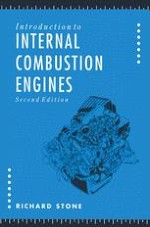1992 | OriginalPaper | Buchkapitel
Spark Ignition Engines
verfasst von : Richard Stone
Erschienen in: Introduction to Internal Combustion Engines
Verlag: Macmillan Education UK
Enthalten in: Professional Book Archive
Aktivieren Sie unsere intelligente Suche, um passende Fachinhalte oder Patente zu finden.
Wählen Sie Textabschnitte aus um mit Künstlicher Intelligenz passenden Patente zu finden. powered by
Markieren Sie Textabschnitte, um KI-gestützt weitere passende Inhalte zu finden. powered by
This chapter considers how the combustion process is initiated and constrained in spark ignition engines. The air/fuel mixture has to be close to stoichiometric (chemically correct) for satisfactory spark ignition and flame propagation. The equivalence ratio or mixture strength of the air/fuel mixture also affects pollutant emissions, as discussed in chapter 3, and influences the susceptibility to spontaneous self-ignition (that is, knock). A lean air/fuel mixture (equivalence ratio less than unity) will burn more slowly and will have a lower maximum temperature than a less lean mixture. Slower combustion will lead to lower peak pressures, and both this and the lower peak temperature will reduce the tendency for knock to occur. The air/fuel mixture also affects the engine efficiency and power output. At constant engine speed with fixed throttle, it can be seen how the brake specific fuel consumption (inverse of efficiency) and power output vary. This is shown in figure 4.1 for a typical spark ignition engine at full or wide open throttle (WOT). As this is a constant-speed test, power output is proportional to torque output, and this is most conveniently expressed as bmep since bmep is independent of engine size. Figure 4.2 is an alternative way of expressing the same data (because of their shape, the plots are often referred to as ‘fish-hook’ curves); additional part throttle data have also been included.
